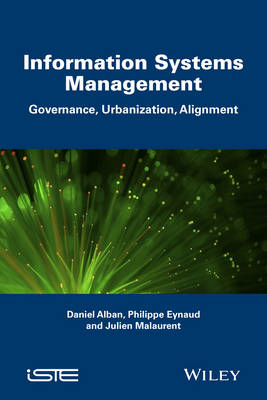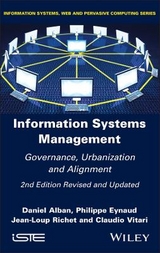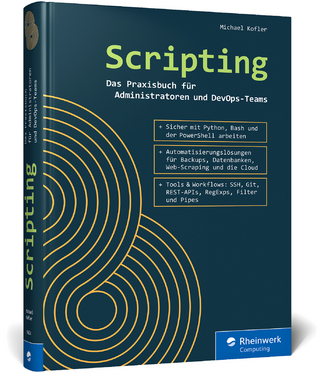
Information Systems Management
ISTE Ltd and John Wiley & Sons Inc (Verlag)
978-1-84821-855-0 (ISBN)
- Titel erscheint in neuer Auflage
- Artikel merken
Information Systems Management is intended to sensitize the heads of organizations to the issues raised by information systems (IS). Through its pedagogical presentation, the book ensures that issues related to IS are not left solely to the experts in the field.
The book combines and analyzes three key concepts of IS: governance, urbanization and alignment. While governance requires the implementation of a number of means, bodies and procedures to manage IS more effectively, urbanization involves visualization methods to enable the manager to take into account the different levels of the organization of an IS and their coherence. Finally, alignment assesses the ability of the IS to make a significant contribution to the organization's strategy.
Daniel Alban is a former Senior Lecturer in Management Sciences and Information Systems at Paris Descartes University (2005-2017), France. Philippe Eynaud is Professor of Management Sciences and Information Systems at Sorbonne Business School, University of Paris 1 Panthéon-Sorbonne, France. Julien Malaurent is Professor and Head of the "Managing IT in a Digital Age" and "Digital Transformation" courses at ESSEC, France. Jean-Loup Richet is Associate Professor of Management Sciences and Information Systems at Sorbonne Business School, University of Paris 1 Panthéon-Sorbonne, France. Claudio Vitari is Professor of Management Science at Aix-Marseille University, France.
Foreword xi
Introduction xv
Part 1 Governing the Stakeholders 1
Introduction to Part 1 3
Chapter 1 Information Systems Stakeholders 5
1.1 The technological environment of IS stakeholders, and its development 6
1.2 Impact of the developing technologies on organizational management 8
1.3 Understanding and categorizing the human stakeholders in IS 11
1.3.1 The days of the pioneers 11
1.3.2 The birth of the information systems manager, a change in status 13
1.3.3 Organizing functions around IS governance 14
1.3.4 Extending IS from internal stakeholders to external stakeholders 18
Chapter 2 From Global Governance to IS Governance 21
2.1 From organizational governance to IS governance 22
2.1.1 COSO standards 24
2.1.2 The Sarbanes–Oxley Act 25
2.2 Defining IS governance 26
2.3 IS governance in an outsourcing strategy 28
2.3.1 The scope of outsourcing and the stakeholders involved 30
2.3.2 A dual strategy 31
2.3.3 Transactional governance 32
2.4 IS governance in a resource pooling strategy 33
2.4.1 Hybrid forms between hierarchy and market 34
2.4.2 Self-organized forms 37
2.5 IS governance in a co-management strategy with stakeholders 39
2.5.1 The forgotten stakeholders 40
2.5.2 Recognizing stakeholder contributions 42
2.5.3 A multifaceted approach with a strong HR emphasis 43
2.6 Open innovation type software 44
2.7 Exercise: Bacchus 45
Chapter 3 IS Governance in Practice 49
3.1 IS governance organizational models 50
3.1.1 Centralized governance 50
3.1.2 Decentralized governance 51
3.1.3 Federal governance 52
3.1.4 Internal software and computing services-type governance 53
3.2 IS governance benchmarks 54
3.2.1 Control Objectives for Information and related Technology (COBIT) 56
3.2.2 Enterprise Value, Governance of IT Investments (ValIT) 58
3.2.3 IT Framework for Management of IT-Related Business Risks (RiskIT) 59
3.2.4 Global Technology Audit Guide (GTAG) 60
3.2.5 Information Technology Infrastructure Library (ITIL) 60
3.2.6 International Organization for Standardization/International Electrotechnical 61
3.2.7 Specific benchmarks 62
3.3 Implement a best practice benchmark 63
3.4 Exercise: GreenNRJ 65
Part 2 Urbanizing the Territories 69
Introduction to Part 2 71
Chapter 4 The Information Systems Territory 73
4.1 The territory 73
4.2 Organizational and microeconomic territory 75
4.2.1 The hierarchical-functional territory 75
4.2.2 Business process territory 77
4.2.3 Organizational structures 78
4.3 Organizational territory and mesoeconomics 81
4.4 The information systems territory 83
4.5 The information systems territory and the organization’s territory 85
4.5.1 The information systems territory and the hierarchical pyramid 85
4.5.2 Information systems territory and functional silos 86
4.5.3 Information systems territory and the hierarchical-functional pyramid 89
4.6 Information systems territory and systems engineering 89
4.7 Alignment between the firm’s territory and the information systems territory 94
4.8 Mapping the information systems territory 100
4.8.1 Process modeling 100
4.8.2 Function modeling 100
4.8.3 Modeling the software 101
4.8.4 Modeling the hardware 101
4.8.5 Modeling the informational content 101
4.8.6 Integrative modeling 102
4.9 Exercise: Linky and Enedis’ information systems territory 108
Chapter 5 Territorial Urbanization 111
5.1 Urbanization 111
5.2 Urbanization of information systems 113
5.3 Urbanization: approaches and objectives 116
5.3.1 Understanding the existing information system 116
5.3.2 Defining the target information system and the associated trajectory 118
5.3.3 Providing the tools to steer development 119
5.4 The planner’s job 121
5.5 The limits 124
5.6 Exercise: the urbanization of France’s government information systems 127
Chapter 6 Urbanizing the Inter-organizational Information System 129
6.1 Inter-organizational territory 129
6.1.1 Inter-organizational territories and the value chain: the sectorial chain 130
6.1.2 Inter-organizational territories and the value chain: the ecosystem 134
6.2 Inter-organizational territory of the information system 135
6.2.1 The extended information system 136
6.2.2 The cooperative information system 136
6.3 Alignment and representation of the inter-organizational information systems territory 142
6.4 Urbanization of an inter-organizational information system 143
6.4.1 Cloud computing 145
6.4.2 Computing standards 148
6.4.3 Free software 150
6.4.4 Open data 153
6.5 The job of the inter-organizational information systems planner 154
6.6 Exercise: AGK 156
Part 3 Project Alignment 159
Introduction to Part 3 161
Chapter 7 Information Systems Project Management 163
7.1 Strategy of information systems projects 163
7.1.1 The strategic plan 164
7.1.2 Business department’s strategy 164
7.1.3 Operational project governance 164
7.1.4 Budget management 166
7.1.5 Quality system 167
7.2 Roll-out of a traditional information systems project 167
7.2.1 Defining, researching and initializing the project 167
7.2.2 Developing and building the information systems solution 168
7.2.3 Management and roll-out of the IS solution 168
7.2.4 Project assessment 169
7.3 Agile information systems projects: a development methodology, a process and a philosophy 169
7.3.1 An empirical, iterative, incremental approach 171
7.3.2 Can all projects become agile? 173
7.4 DevOps: making the link between information systems developments and IS management committee procedures 175
7.5 Security in information systems projects 177
7.5.1 Risk parameter assessment 178
7.5.2 Risk analysis 179
7.5.3 Security in development 180
7.5.4 Security for putting into production and deployment: towards a permanent watch 181
7.6 Exercise: cybersecurity in projects, managing tomorrow’s threats 182
Chapter 8 Technology, Alignment and Strategic Transformation 185
8.1 The alignment of stakeholders, territories and projects 186
8.2 Strategic alignment 187
8.3 Competition, technological revolutions and new strategies 190
8.4 Strategic transformation linked to information systems and new technologies 194
8.5 Towards a dynamic perspective of strategic transformation linked to the information system 198
8.6 Exercise: TechOne: Big Data and the Cloud 198
Chapter 9 Auditing Information Systems 201
9.1 What is an audit? 201
9.1.1 A need for measurement: alignment by audit 201
9.1.2 The place of the audit 203
9.2 Information systems and auditing 205
9.2.1 Information system internal audits 206
9.2.2 Information system external audits 207
9.3 The audit process 210
9.3.1 Structuring an information system audit project 211
9.4 Scope of the audit 212
9.4.1 Domains and processes audited 214
9.5 Audit repositories 215
9.6 Towards an approach via the risks of strategic alignment? 217
9.7 Conclusion 219
9.8 Exercise: an auditor’s view 219
Conclusion 221
Glossary 231
References 241
Index 251
| Verlagsort | London |
|---|---|
| Sprache | englisch |
| Maße | 160 x 236 mm |
| Gewicht | 590 g |
| Themenwelt | Mathematik / Informatik ► Informatik ► Netzwerke |
| Mathematik / Informatik ► Informatik ► Theorie / Studium | |
| ISBN-10 | 1-84821-855-9 / 1848218559 |
| ISBN-13 | 978-1-84821-855-0 / 9781848218550 |
| Zustand | Neuware |
| Haben Sie eine Frage zum Produkt? |
aus dem Bereich



